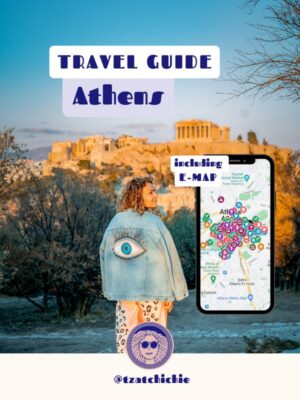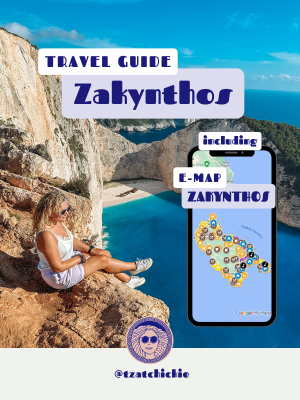The Best Times to Fly to Greece: Complete Guide

Planning a trip to Greece? Whether you’re dreaming of exploring the Greek Islands, immersing yourself in the cultural richness of the Greek mainland, or simply looking for the best flight deals, timing is everything. In this guide, we’ll dive into the best times to fly to Greece, with tips on avoiding large crowds, finding the cheapest days to fly, and enjoying the best weather and experiences that align with your preferences and idea of a Greece holiday. Plus, we’ll explore how bad and good weather, peak travel seasons, and international flights can affect your plans.
If you want more practical information about visiting Greece, including a full packing list and ferry guide, check out my ”Ultimate Tourist Guide to Greece” or my other travel guides:
-

Athens, Greece – Travel Guide (e-book)
12,99€ Add to cart -

Corfu Island, Greece – Travel Guide (e-book)
12,99€ Add to cart -

Milos Island, Greece – Travel Guide (e-book)
12,99€ Add to cart -

Naxos Island, Greece – Travel Guide (e-book)
12,99€ Add to cart -

Paros Island, Greece – Travel Guide (e-book)
12,99€ Add to cart -

The Ultimate Tourist Guide to Greece (e-book)
12,99€ Add to cart -

Zakynthos Island, Greece – Travel Guide (e-book)
12,99€ Add to cart
Why Timing Matters When Flying to Greece
Greece is a diverse destination with something for every traveler— mountains and rivers, ancient ruins, sunny beaches with warm waters, and world-famous cuisine. But when (and where exactly) you go can impact everything from your budget to the overall experience. Considerations include:
- Average temperature (from winter to hot summer weather)
- Flight costs
- Hotel, flight and sunbed rates
- Crowd levels
- Access to archaeological and historical sites and cultural festivals
- Weather conditions and ferry service reliability
- Ferry routes, domestic flights and international flights availability
- Whether restaurants, tours, beach bars, etc., are open/available or not
Choosing your travel dates wisely can save you money and elevate your travel experience. Various factors influence flight route availability, tourist season highs and lows, and more. Let’s explore these in depth.
Spring (March to May): A Great Time to Visit
The spring months are often considered the best months to visit Greece. Late spring is arguably one of the best times to fly to Greece, especially for those interested in outdoor activities and ancient history (visiting archeological sites).
- Average temperature highs: In the high 60s to low 70s (°F), which is 18°C to 23°C
- Sunny days: Increasing steadily from March onward, summer weather establishes itself within May
- Fewer tourists: This shoulder season offers elbow room at major sites
- Cheapest time: Flights and hotel rates are the most affordable at this time, as it is low season/shoulder season
- Greek Islands: Begin to open up for the tourist season
- Water temperatures: 18-22 °C, April is very early for swimming, from half May in my opinion it is doable although the water surely isn’t warm yet
- Destinations: Ideal for exploring mainland Greece and the Peloponnese – ancient sites, olive groves, and mountainous areas. But also: Crete, Rhodes, and Santorini.
This makes spring in Greece is the right time for greece tours focused on historic sites and natural landscapes. It offers a combination of pleasant (not too hot, not too cold) weather, fewer crowds, and blooming nature. In summer, archeological sites are fuming hot with barely any shade. It’s a physical challenge to spend a lot of time there. So in spring, go to the Greek mainland or the Peloponnese and visit Delphi, Meteora, Olympia, Epidaurus, Corinth and more. Hike the Vikos gorge and enjoy the stone bridges of Zagoria.
Or go to the islands of Crete or Rhodes. Not primarily for a beach holiday, cause until the end of April and beginning of May not many of them will be open, and the water is quite fresh to swim in. Also, pools in Greece 99% of the case are not heated so they’re cold to swim in as well until half May or the end of May. Instead you should go to hike the Cretan gorges with a pleasant temperature, find life in cities like Rhodes town, Chania and Rethymno, enjoy the archeological sites these islands offer and tan on the beach on good weather days. Santorini is also a great option. Basic facilities are open year-round in Fira, the capital. And since Santorini is all about the unique view but gets severely overcrowded in summer, it’s good to visit in April or Early May.
Greek Orthodox Easter often falls in April or early May—celebrations are vibrant, and it’s a fantastic way to experience Greek culture. Just note that flight and ferry options get booked out around this period, so early booking is essential. Wet weather is not uncommon early in the season, but it usually clears up by the end of April. Facilities such as beach bars and restaurants on Greek islands start opening either after Greek Easter or from the 1st of May on larger and or popular islands. Especially those that receive charter flights (direct flights) from all over Europe. Things will be open till half or the end of October there. On smaller, less crowded islands, the season is shorter (June-September).
Summer (June to August): High Season Energy
The height of summer in Greece brings summer holidays! Warm temperatures, numerous traditional local festivals, and, of course, the crowds. This is when international travel to Greece peaks.
- Average temperature: High 70s to upper 80s (°F), which is 25°C to 35°C. With occasional highs up to +40°C
- Hot weather: Ideal for sunbathing, swimming, boat trips, island hopping, and relaxing
- Summer crowds: From July, expect bustling streets and beaches and busy ferry ports, especially at popular destinations like Santorini and Mykonos
- Prices: Ticket prices and hotel rates reach their peak between half July and the end of August
- Great months: June and the last days of August for slightly less intensity
- Main islands: Cyclades, Crete, Dodecanese, and Ionian Islands see heavy traffic
- Water temperatures: In June, water starts warming up properly but still isn’t always on the average 25°C level. This quickly changes during July and August, but also because the temperatures are so high in those months a refreshing dive into the sea is very welcome.
- Flight & ferry options: The most frequent timetables you will find, but (in respect to flights) pricier and, sometimes, fully booked
June in my opinion is the sweet spot and best month for visiting. Pleasant, full-on summer weather, local festivals (panigiria) beginning to happen, and summer energy starting to build. And another cultural highlight of Greece, the Athens Epidaurus festival. By June, all restaurants, beach bars, activities etc. even on the smallest island will have opened. But crowds and prices are not nearly as bad as in July and especially August. June is the perfect month to visit the popular islands that are mostly visited for a beach holiday. Such as the Cyclades (Mykonos, Paros, Naxos, Milos). But also the Cretan cities and most popular Ionian islands like Zakynthos and Corfu. I personally love that in June, days are longest. But other people prefer September because the water temperature is warmer.
By July, the tourist season is in full swing. If your personal preferences lean toward nightlife and events, this might be your ideal window. However, it’s not for everyone. If you prefer elbow room, lower fares, and cooler temperatures, summer may not be your best bet. Loyalty programs and booking tools like Google Flights or Kayak data can help secure deals during this high-demand period. Consider checking prices from nearby airports for additional savings.
If you hate crowds but your only option is to go in July or August, try the smaller Greek islands that are a bit more unknown, or coastal regions on the Greek mainland that mostly attract locals. Think of: Kythira, Patmos, the coast of Epirus from Mytikas to Igoumenitsa (except from the busy Parga), Pelion, etc.
Tourism in Greece is at its absolute peak in the week of August 15th. This is one of the most important days of the year, and a national holiday. Greeks tend to take at least a long weekend off around the 15th of August, so you’ll have all the foreign plus Greek tourist traveling within the country! Prices skyrocket, so if possible, try to avoid this specific week.
Autumn (September to November): The Perfect Shoulder Season
Apart from May and June, early fall is another excellent time to visit Greece. The shoulder months of September and October bring with them the best of both worlds.
- Average highs: High 70s to mid-60s (°F), which is 18°C to 26°C (but in September temperatures surely rise up to 30 °C still). In November, winter slowly starts and temperatures won’t always rise above 20°C
- Fewer tourists: A relaxed vibe returns quickly after August ends, except for the most popular places like Santorini, Mykonos and the Cretan cities
- Warm temperatures: By September, the sea water has had time to warm up all summer and will be about 24°C to 26°C. It is usually very pleasurable to swim in until half October.
- Cheapest month of autumn: October often offers the lowest prices of the fall, while southern islands like Crete or Rhodes still offer beach holidays all month
- Destinations: Crete, Rhodes, Peloponnese, mainland (same as spring)
- Flight & ferry route options: Still relatively frequent and less costly than summer, although summer routes to stop after October
The first half of September is still an amazing time to visit the Ionian islands and the Cyclades. Weather will be like summer, and everything will be open, but with half the crowds. In late September and from October on, weather in those island groups gets less stable week by week. You can technically still encounter a week full of summer weather at the end of October (experience it myself), but you can also have a wet, stormy, windy week.
Your best best for October is definitely an island like Crete. Crete remains vibrant and ‘open’ until the end of October and even November will offer some beach days The weather conditions are stable, and the sea remains warm enough for swimming. This period is ideal for visiting historical sites without crowds and engaging in outdoor activities. Another area that remains warm, but is less busy, is the south of the Peloponnese including Kalamata.
October and November are also amazing for visiting moutaneous areas: hiking Mount Olympus for instance.
On many other islands, from October on, things quickly start closing down. After the end of October, all tourist facilities are locked up until April/May or sometimes even June.
Autumn is also a great time to experience traditional (olive) harvest festivals in mainland Greece and sample local delicacies. If you’re a fan of culture and gastronomy, this could be your perfect time. You can often stay for free if you offer to be a volunteer for the olive harvest. Significant savings can be found on hotels, domestic flights and international flights during this period.
Winter (December to February): A Secret Gem
The winter months are the most underrated time to explore Greece. While not everyone thinks of winter as an excellent time for international travel, it offers unique advantages:
- Cooler temperatures: Ranging from 45°F to 60°F, which is 7°C to 16°C. Occasionally, it’ll reach 20 °C or drop below 0. Even though it doesn’t rain much in Greece as a whole, rain does fall in winter, especially in green or mountainous areas. The Ionian islands are very wet in winter for instance.
- Wintersports: did you know that Greece has over 20 (small) ski resorts? In the mountainous areas it is proper winter weather
- Fewer tourists: Some places feel like your own private paradise, because winter tourism is relatively non-existent in Greece
- Lower fares: Both for flights and accommodations, except for ski resorts around the holidays, their prices obviously peak around that time
- Ancient history: Explore sites like Delphi and the Acropolis with no crowds, if you don’t mind that it could be a gloomy day upon your visit
- Destinations: City trip to Athens, Nafplio or Thessaloniki, winter wonderland in Zagoria and Ioannina, Nymfaio, Edessa and Agios Athanasios, Parnassos, Kalvryta, etc.
- Flight & ferry route options: Winter is not a time for island hopping, ferry routes are greatly reduced and charter flights stop operating
In winter, mainland Greece is the place to be. It is the ideal time for a citytrip. Apart from Athens, Greece has multiple other interesting cities like Thessaloniki, the neoclassical Nafplio, the northern gem of Ioannina and more. From all of these cities, you can reach the mountains within 1-2 hours if you want. So you can combine a city with enjoying a winter wonderland. Yes, from December/January, the mountains get a lot of snow and the many small ski centers that Greece is rich of, open. Nymfaio is a fairytale in winter! Agios Athanasios is also amazing, which you can combine with skiing at Mt. Voras-Kaimaktsalan, swimming in the hotsprings of Pozar, checking out the waterfall in Edessa and visiting the tombs of Vergina. These areas are where life is in winter. Do bring appropriate clothing!
As said before, ferry routes are reduced during winter and it’s not a time for island hopping. On most islands, all tourist facilities will have been closed. If you are in Athens and you encounter very good weather, you could however take a short ferry ride to Aegina or Hydra island, where you can find places open in town all year round. The same goes for the Cretan cities, Corfu town, Ermoupoli in Syros, etc., but do not expect it to be beach weather of beach clubs to be open.
How to Find the Best Deals for Flights & Hotels
No matter your preferred travel dates, use these tips to snag the best flight deals:
- Use online tools like Skyscanner, Kayak and Google Flights: Compare prices and monitor trends
- Avoid the most expensive day: Typically Friday and Sunday
- Fly midweek: Tuesday or Wednesday offer the lowest ticket prices
- Join loyalty programs: Earn points toward discounted or free flights
- Book early: Especially for high-demand months and tourist season, book your flights at least 6 months in advance if possible. To be able to book the best hotels for lower prices, book by January especially for the Cyclades.
- Be smart and flexible with your flight route: Alternative airports can offer lower fares. You do NOT always have to go through Athens. Islands with international airports (such as Mykonos, Santorini, Crete, Rhodes, Corfu, Zakynthos, Kefalonia, etc.) can also be reached directly from lots of European cities. You can easily connect with direct flights to the islands from the United States in Germany, Paris, London, Amsterdam and other places.
- Check nearby airports: Especially if flying from major cities in the U.S., flying from the nearest by airport could turn out to be significantly more expensive than an alternative choice a bit further away. But even within Europe, it pays off to check for (charter) flights from smaller airports instead of main hubs.
Setting price alerts and using historical data from online platforms will give you an edge in finding bargains, especially for off-peak seasons.
Comparing Seasons at a Glance
| Season | Weather Conditions | Crowds | Prices | Best For | ||||
| Spring | Pleasant weather, longer days, cooler water | Low | Lower fares | Culture, hiking, ancient sites, flowers | ||||
| Summer | Hot and sunny | Summer crowds | High | Beaches, nightlife, (local) festivals | ||||
| Autumn | Warm and mild, shorter days, warmer water | Moderate | Affordable | Foodies, ancient sites, hiking, elbow room | ||||
| Winter | Cool temperatures | Minimal | Lowest prices | Skiing, city trips, museums |
Special Dates and Events to Consider
- Holy Week (Greek Orthodox Easter): Often in April—a spiritual and cultural must-see, but big movement of crowds of Greeks going to their family for the weekend.
- August 15th: Peak travel season with limited ferry service and packed cities
- New Year holidays: Festive atmosphere in Athens and Thessaloniki
- Harvest season: September to October, particularly in olive groves and wine regions
- Numerous festivals: From spring music fests to local festivals and fall food celebrations
Final Travel Tips
- Check visa and entry requirements: For now, you do NOT need an ESTA to enter Europe. But (especially for U.S. citizens and other people coming in for overseas), always read the website of your own government to check for entry requirements and make sure your passport is valid for at least 6 months still.
- Pack layers: Especially for visits that are not in June-September, you need to layer up!
- Use offline maps: Helpful for navigating the islands, because internet connection is not super strong everywhere.
- Travel insurance: Always a must, just in case something happens!
- Stay flexible: With your flight route and travel dates for best results
The Verdict: When Is the Best Time to Fly to Greece?
- So, what is the best time to fly to Greece? The answer depends on your priorities:
- For beach lovers: June to early September (warm weather, summer crowds)
- For culture seekers: March to May and September to October (pleasant weather and fewer tourists)
- For city-trippers and winter lovers: November to February (lowest prices and off-peak perks)
- For balance: May, Early June and September—great weather, great prices, great experiences
Ultimately, there is no single perfect time—just the perfect time for you. Consider the various factors that matter most to you, from weather conditions and flight options to personal preferences and planned activities.
Ready to book your dream trip? Whether it’s the ancient sites of Athens, the peaceful olive groves of the Peloponnese, or a quiet escape to the Ionian Islands—Greece is always a good idea. Have a good time in Greece. And remember to check out my ”Ultimate Tourist Guide to Greece”, a 184-page e-book with all the practical info about Greece you will need.
-

Athens, Greece – Travel Guide (e-book)
12,99€ Add to cart -

Corfu Island, Greece – Travel Guide (e-book)
12,99€ Add to cart -

Milos Island, Greece – Travel Guide (e-book)
12,99€ Add to cart -

Naxos Island, Greece – Travel Guide (e-book)
12,99€ Add to cart -

Paros Island, Greece – Travel Guide (e-book)
12,99€ Add to cart -

The Ultimate Tourist Guide to Greece (e-book)
12,99€ Add to cart -

Zakynthos Island, Greece – Travel Guide (e-book)
12,99€ Add to cart
Did you like it? Then pit in!

Greece tips daily?! 🗺 follow me and don’t miss anything!
Terms and Conditions – Tzatchickie | Privacy & cookie policy
